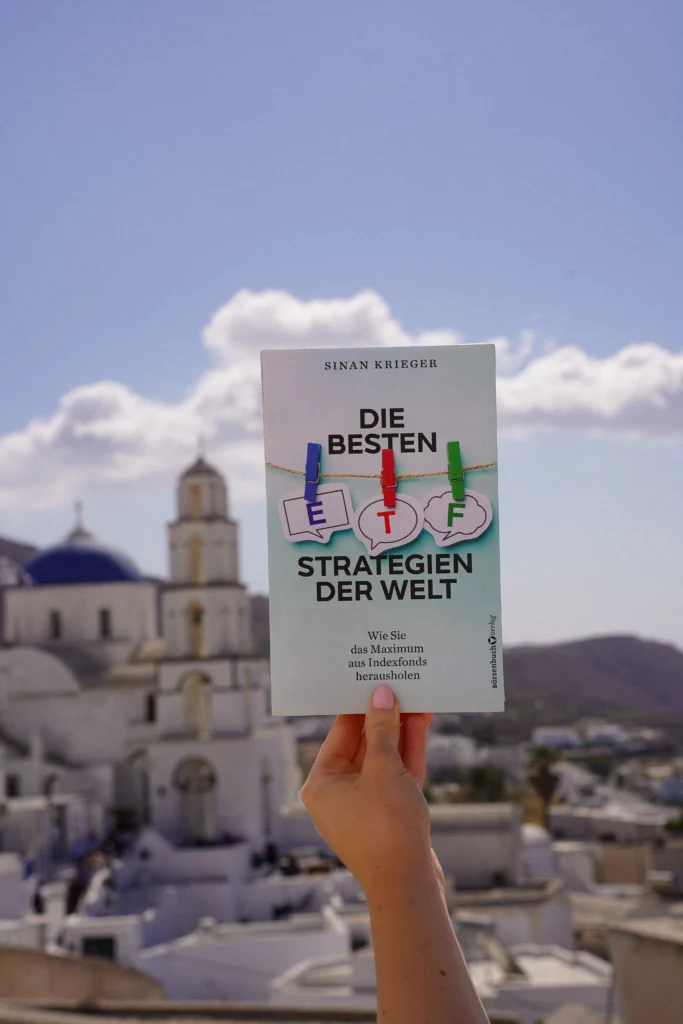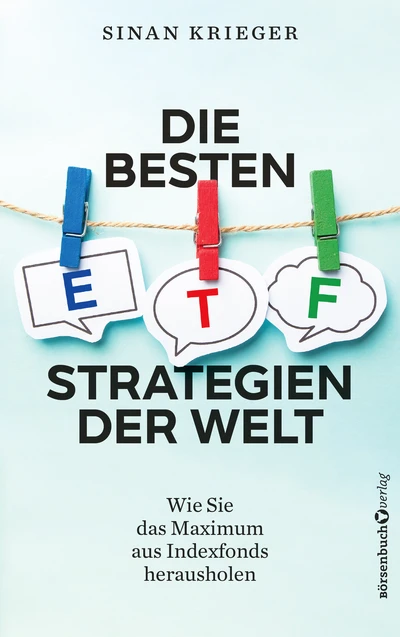
by Sinan Krieger is an entertaining financial book for beginners that aims to provide an overview of various well-known ETF strategies. The author follows this approach in just under 200 pages, but remains far too impartial and superficial for my taste. However, if you are looking for a rough overview and don't want in-depth analyses or even critical classifications, this book will serve you well.

For my taste, it was ultimately too little for a very good rating. Nevertheless, from my point of view it is a good financial book that is well worth reading - especially if you already have some background knowledge and can make your own critical assessments while reading.
In his book, Sinan Krieger takes readers on a journey through the world of exchange-traded funds (ETFs). He quickly shows that the gambling instinct of some investors does not stop at ETFs and that this can result in ideas that are both scientifically sound and emotionally charged, even obscure. To my delight, ETFs have now become one of the most popular forms of investment.
However, the scientifically based approach of passivity on the capital markets with a focus on sensible portfolio construction has sometimes been lost and is increasingly diluted in popular core-satellite strategies, whereby satellite can be synonymous with pretty much any level of active investing. However, emotionally driven prioritizations of different sectors, niches or distributions are also reflected in the strategies presented.
The author approaches his overview with the aim of getting the most out of these index funds for investors, using the Sharpe ratio in particular as a yardstick. For me personally, this is the first - and above all avoidable - weakness of the book. In the first few pages, Sinan Krieger himself shows in his descriptions that he is aware of the limits of this risk indicator and even provides a slightly more advantageous alternative, but then later uses the Sharpe ratio in his backtests. This is completely incomprehensible to me.
"I consider this "further development" or "refinement" of the Sharpe ratio to be extremely useful, as in practice hardly any investor would complain about sudden upward price movements, would they? You will therefore come across both risk ratios more frequently in this book. Where indicated in the original studies or possible in the backtest, my comparisons are based on the Sharpe Ratio. This is geared a little more to the needs of investors."
Sinan Krieger
This argument is not coherent in itself. If the Sortino ratio described earlier on the page is an "extremely useful further development or refinement of the Sharpe ratio", why is it not used primarily on the following pages and why is the Sharpe ratio then, despite all its disadvantages, "more geared to the needs of investors"? That makes no sense to me at all.
Personally, I would be delighted if in Books more complex and realistic risk indicators would finally be used to assess portfolio performance for beginners. So far, I have not read any studies based on skewness and kurtosis or even co-kurtosis in any financial book. Ratios that shockingly few active investors out there even know about or even use.
One could argue that, in Nassim Taleb's words, they are not even aware of the actual risk. Anyone who still uses standard deviation and volatility to assess the risk of their investment is bearing a risk that they are not even aware of. However, my intention is not to give a lecture on statistics, but to draw attention to the concentrated ignorance out there.
In terms of content, Sinan Krieger unfortunately does not use any of these higher-value risk indicators, but leaves it at standard deviation and volatility, which at least somewhat dilutes the "critical classification", if you can even call it that, of the 17 different ETF strategies. These include many simple buy-and-hold strategies, but also some more complex timing strategies. At this point, a strong reminder to all those who are all too willing to be tempted: "Time in the market beats timing the market." Ken Fisher

At the beginning, Sinan Krieger explains in detail the usefulness of ETFs as an investment vehicle. For him, they are the ideal form of investment for long horizons. However, he sees a need for improvement, particularly for investors with short and medium-term horizons, and would like to remedy this.
He repeatedly emphasizes that investors often do not have the patience or the financial means to wait decades for returns. In this context, Sinan Krieger encourages readers to carefully consider their investment strategies and adapt them to their individual needs. Personally, however, this does not go far enough for me. I keep reading these "individuality arguments" in financial books for beginners, but I simply don't go along with them.
For me, it makes less sense to give emotional beings emotional strategies to satisfy them - although it is scientifically proven that this is not necessarily the best idea. You only need to read the book Greedy. In love. Panicked read by Jessica Schwarzer or The art of clever thinking by Rolf Dobelli.
In my opinion, it would make much more sense to repeatedly convey to readers - especially beginners - that emotions have no place on the capital markets. Neither greed nor fear nor sympathy for companies or brands are effective there. Experienced investors have found ways to at least channel their emotions, but definitely not to let them have the upper hand when it comes to investment decisions.
So, even if some run-of-the-mill financial blogger has once again advised you to do so: don't buy shares in companies that you think are particularly great, use yourself or anything like that. This may be an "exciting" and "attractive" entry into the stock market, but it has absolutely nothing to do with serious investing and, frankly, the majority of people out there have neither the time nor the capital to afford such escapades in their retirement provision.
"On [...] you as a private investor can "backtest" almost any strategy, i.e. view past performance. However, the evaluations go much further than just the pure price performance. The Sharpe and Sortino ratios mentioned above can be called up, as can the maximum drawdowns, any recovery periods, rolling returns and much more. The display of rolling returns is what makes the evaluations so exciting: investors can see after how many years they would have been back in the black with a certain strategy, even at the worst possible entry point."
Sinan Krieger
As almost the entire book is based on this, a whole range of tools are of course also presented that turn what is actually a passive approach with a scientific foundation into backtesting madness. It should be noted that backtesting only shows what has happened in the past and does not explain why it happened. They are therefore only an indicator at best, but never the primary indicator.
Every student of economics should know that long data series of the capital markets sometimes contain glaring outliers that can set the direction. A single company such as Enron, Wirecard and the like can distort the entire performance due to unforeseeable scandals. Backtests are certainly interesting, but nothing more. You should definitely not glorify yourself too much, although this happens again and again among financiers and is even presented as "science".
At this point a few words about the author:
Sinan Krieger is a business journalist and co-founder of a successful YouTube financial channel. In his career, he has worked for Handelsblatt and Focus Money, among others. Today he writes for BÖRSE ONLINE.
In the end, for a self-proclaimed best-of book by an experienced financial journalist, I would have expected more sophisticated risk/return assessment systems or critical classifications of the strategy presented. In retrospect, his contribution to the book seems to me to have remained rather pale and I think that's a shame.
"It is clear to see that those companies that have been able to continuously increase their dividends not only record the best long-term performance, but also fluctuate the least and therefore have the best risk/return ratio of all share groups in the study."
Sinan Krieger
Especially with regard to dividend strategies, Sinan Krieger, in my opinion, falls into chicken-and-egg problems. He simply makes things too easy for himself with his backtest causal chains and also lacks tax background knowledge in his further explanations:
"Why do I find this strategy so appealing? Because it can be a great addition, especially for employees or retirees who are used to a monthly payment cycle. Sure, the dividend yield doesn't increase just because the distributions are split over a total of twelve months, but it can be quite attractive for some people in terms of their financial planning if they can rely on a monthly distribution."
Sinan Krieger
One of the most naive arguments regarding dividend payouts that I have to read again and again. Of course it's nice to receive dividends every month. But you must not forget that dividends are not paid on top, but shrink the portfolio by their value. They have exactly the same effect on the portfolio as a partial sale. However, this would be much more favorable from a tax point of view, as in the case of a partial sale (all above the tax-free allowance) the profit share still has to be taxed - in the case of ETFs even only at 70% - and in the case of a distribution the entire amount. Partial sales can also be individualized and are sometimes cost-neutral with today's brokers or at least - taking into account the tax advantage - cannot be executed at significant costs.
That this is still being used as an argument at all. Either people just don't understand it or they just don't want to understand it, but dividends above the tax-free amount are not much more than an emotional negative premium.
In itself, however, it remains an interesting book. With a little more effort and a more critical view, it could certainly also become a highly recommended book. From a private investor's point of view, I ask myself what the point of a financial book is if it simply presents me with strategies and fails to really put its finger in the wounds, appeal to people's emotional weaknesses, etc. It makes no sense to me to serve the irrationalities of some investors with emotionally influenced strategies.
Accordingly, I can only give this book three stars in the end. Because although it gives a good overview and is basically well written, it is in no way the big hit or comes close to other beginner works by Jessica Schwarzer, Gerd Kommer, Pirmin Hotz or Tony Robbins.
